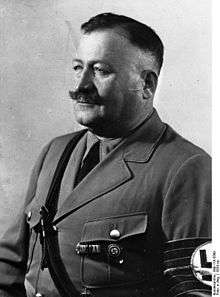Christian Weber (SS general)

Christian Weber (25 August 1883 in Polsingen – 11 May 1945 in the Swabian Jura) was a German Nazi Party official and Schutzstaffel Brigadeführer.
Biography
Along with the likes of Emil Maurice, Ulrich Graf, and Max Amann, Weber, a bouncer at a seedy bar, was amongst the earliest political associates of Adolf Hitler.[1] Ever ready for a fight, Weber carried a riding crop with him, a habit shared by Hitler in these early years.[2] Otto Strasser would later claim that Weber was also a pimp at this time, although he had a hatred of Weber whom he denounced as an "ape-like creature" and "the most despicable of Hitler's underlings".[3] In late 1921 Weber was one of Hitler's cohorts when the Nazis attacked a meeting of the Bavarian League. Hitler personally beat up the League's leader Otto Ballerstedt, an event that saw the future Führer serve a month in prison.[4] At some stage before 1923 Weber lost an eye and often wore a specially made pair of glasses as a result.[5]
Following the Beer Hall putsch Weber, by then a horse trader, was owed $1000 by Hitler after he had bought the debt from Ernst Hanfstaengl.[6] Weber would insist on Hitler paying the debt in full.[7] The two however remained close and Hanfstaengl later claimed that Weber was one of the few who could make fun of Mein Kampf in Hitler's company.[8]
A city councilman in Munich, he was effectively the boss of the city following the Nazi seizure of power.[9] Weber became something of a hate figure in the city, particularly amongst the middle classes and he became a by-word for corruption as it was regularly questioned how this former hotel bellboy had come to own a number of hotels, villas, petrol stations, a brewery, the city's racecourse and bus service as well as a home in the Munich Residenz.[10] Other titles that he was granted included presidency of the Reichsjagdmuseum and the League of German Riding Stable Owners.[11] On the Night of the Long Knives Weber was amongst those SS men who travelled to Bad Wiessee to purge the Sturmabteilung leadership.[12] Hitler personally rewarded him for his involvement by promoting him to the rank of Oberführer in the SS.[13]
Kristallnacht
Ever on the lookout for a chance to enrich himself, Weber was active on Kristallnacht when he took a group of SS men, including a young Hermann Fegelein, to Planegg where they ransacked the estate of Jewish nobleman Baron Rudolf Hirsch. The estate would eventually pass into Weber's possession.[14] Weber also took care of security arrangements for Nazi functions in Munich although he received criticism for this when his plans failed to prevent Georg Elser's bomb attack on the Bürgerbräukeller on 8 November 1939 which missed Hitler and a number of other leading Nazis including Heinrich Himmler and Alfred Rosenberg by only ten minutes.[15] Despite this Weber remained important in Munich, although Gauleiter Paul Giesler was his rival. The two clashed in 1943 over the continuation of horse racing in the city and the dispute was ultimately brought to Hitler himself, where Giesler argued it should be banned as it was not conducive to total war. Hitler agreed in principle with Giesler but, due to the respect for his Alter Kämpfer comrade, he allowed racing to continue at the Theresienwiese only.[16]
Death
Weber died in 1945 after being arrested by the United States Army in Berlin. He was one of a number of prisoners being carried in an open-backed lorry when the vehicle overturned. Weber suffered terminal injuries in the accident.[17] His body was interred in a mass grave at Heilbronn.[18]
References
- ↑ Sherree Owens Zalampas, Adolf Hitler: A Psychological Interpretation of his Views on Architecture, Art, and Music, Popular Press, 1990, p. 40
- ↑ Joachim C. Fest, Hitler, Houghton Mifflin Harcourt, 2002, p. 135
- ↑ Otto Strasser, Hitler and I, READ BOOKS, 2008, p. 86
- ↑ Wulf Schwarzwäller, The Unknown Hitler, Berkley Books, 1989, p. 75
- ↑ David Jablonsky, The Nazi Party in Dissolution: Hitler and the Verbotzeit 1923-25, Routledge, 2013, p. 185
- ↑ Konrad Heiden, The Fuehrer, Robinson Publishing, 2009, pp. 203–204
- ↑ Konrad Heiden, A History of National Socialism, Taylor & Francis, 1971, p. 101
- ↑ Ian Kershaw, Hitler 1889–1936: Hubris, Penguin Books, 1999, p. 675
- ↑ James P. O'Donnell, The Bunker, Da Capo Press, 2001, p. 180
- ↑ Ian Kershaw, Popular Opinion and Political Dissent in the Third Reich, Bavaria 1933–1945, Oxford University Press, 2002, p. 149
- ↑ Schwarzwäller, The Unknown Hitler, p. 212
- ↑ Heiden, The Fuehrer, p. 593
- ↑ John Michael Steiner, Power Politics and Social Change in National Socialist Germany: A Process of Escalation into Mass Destruction, Walter de Gruyter, 1976, p. 61
- ↑ Alan E. Steinweis, Kristallnacht 1938, Harvard University Press, 2009, pp. 79–80
- ↑ Martyn Housden, Resistance and Conformity in the Third Reich, Routledge, 1997, p. 174
- ↑ Ian Kershaw, Hitler 1936–1945: Nemesis, Penguin Books, 2001, pp. 575–576
- ↑ Seite 479 ZBLG 57 (1994)
- ↑ Dös Viech g'fallt mir
|